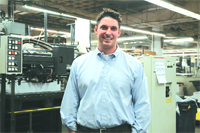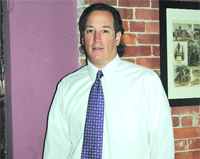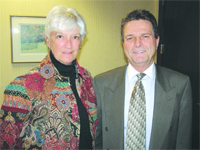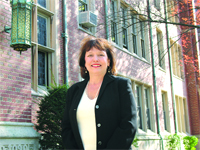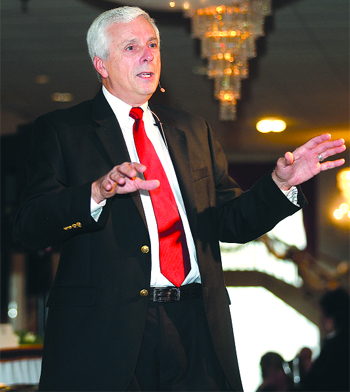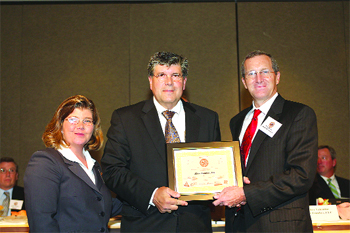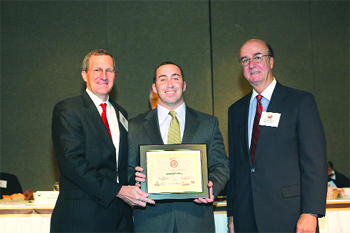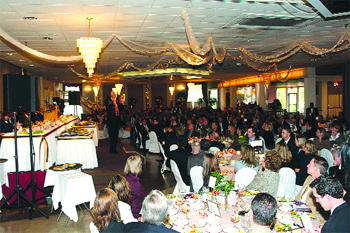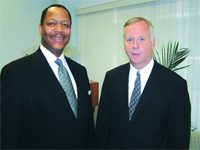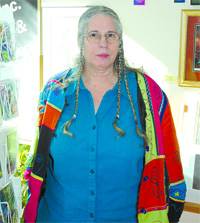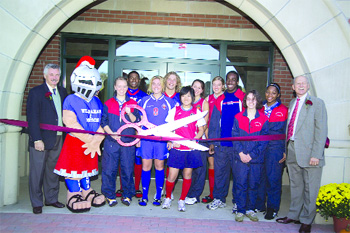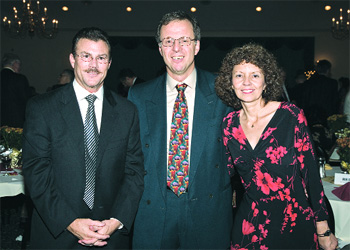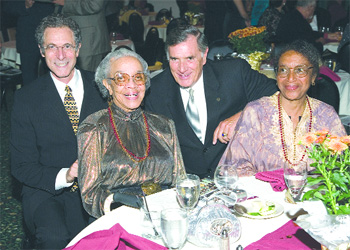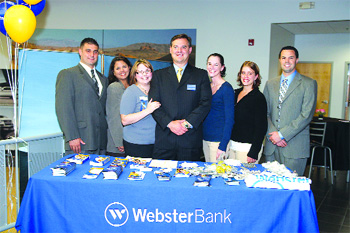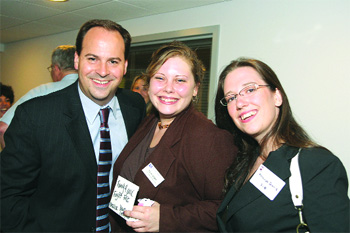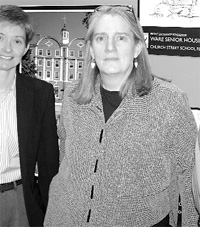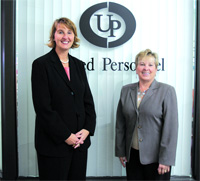While there is some general understanding within the business community of a recognized link between education, especially early-childhood education, and workforce development, many are still missing that message. A Nov. 19 conference will attempt to drive that point home and, in the process, mobilize area business owners and managers for what will be an ongoing fight to ensure that companies have qualified workers for the short and long term.
Bill Ward calls it “an economic imperative.” That’s how he chose to describe this region’s need to focus on workforce development for the long term and, even more specifically, to drive home the connection between education, at all levels, and economic development.
Some business owners and managers understand this relationship, said Ward, director of the Regional Employment Board of Hampden County, but too many do not. Changing that equation is the unofficial mission of a group of area business and civic leaders who will punctuate their efforts with a conference titled ‘Building a Better Workforce: Investments in Education and Early Development.’
It will feature, among other speakers, Dr. James Heckman, the Nobel laureate in Economics from the University of Chicago, who will present the economic case for investing in young children.
In an op-ed piece that appeared last year in the Wall Street Journal, Heckman said there are many reasons why investing in disadvantaged young children has a high economic return. “Early interventions for disadvantaged children promote schooling, raise the quality of the workforce, enhance the productivity of schools, and reduce crime, teenage pregnancy, and welfare dependency,” he wrote. “They raise earnings and promote social attachment. Focusing solely on earnings gains, returns to dollars invested are as high as 15% to 17%.”
Sally Fuller hopes these and other numbers resonate with conference attendees. Fuller is project director of the Cherish Every Child Initiative launched by the Irene E. and George A. Davis Foundation. Cherish Every Child has a number of focus points, she said, but has made universal early-childhood education one of the biggest planks in its platform.
Fuller and others involved with planning the Nov. 19 conference hope to energize those in attendance for what will be a lengthy and challenging battle to improve education at all levels and, eventually, build a bigger, stronger workforce for the region.
“I have a Chinese menu full of options for business people who want to get involved,” said Fuller, using the word interventions for the first of many times to describe what individuals and companies can do. Menu items include everything from tutoring programs to mentoring junior high school students; from initiating literacy programs to lobbying state legislators to fund universal early education.
Some businesses are already doing such things, and some view it as a “good thing they can do,” said Fuller, adding quickly that such thought patterns need to be altered, because such interventions go well beyond good deeds — they are part of a larger economic-development strategy.
“The research clearly shows that if we can intervene with children at a very early age, that will have a significant economic impact,” she said. “Granted, it’s way down the road, but it’s there, and it’s real.”
Carol Baribeau agreed. As regional director of Public Affairs for Verizon, she’s been involved in a number of programs to promote literacy and early childhood education — and she’s heard Heckman’s message about reaching children at an early age.
“I’ve seen a huge amount of research and science that’s telling us we need to begin the quality education at the youngest, youngest levels,” she said. “We need everyone — educators, families, policy makers — to understand that education is truly a life-long process, and it has to begin at the earliest ages.”
In this issue, BusinessWest turns a spotlight on the workforce-development conference, the motivation behind it, and most importantly, what organizers say needs to happen when it’s over.
Schools of Thought
They’re called “dropout factories.”
That’s the term used by the authors of a nationwide study on graduation rates to classify high schools where no more than 60% of a freshman class will graduate from that institution. Springfield has four of these factories — Central, Commerce, Putnam, and the High School of Science and Technology — while Holyoke has two, and Greenfield and Ware also find their high schools on the list.
These dropout numbers comprise just part of the qualitative and quantitative evidence that points to a mounting problem in the Pioneer Valley, said Ward, one that will have serious consequences for the economy if it is not addressed, and soon.
“These dynamics, on some scale or another, exist in all urban areas,” he noted, referring to dropout rates, poverty, crime, homelessness, and others that can be traced back to disadvantaged youths. “But once the problem reaches a certain scale or proportion — with more and more children dropping out of school and more people going into poverty — it begins to have a more significant impact on the economy.”
And this is the point that Springfield and Holyoke have reached, he told BusinessWest, adding that there are other demographic trends that will impact the future workforce.
Indeed, as he talked about the region, its workforce, and the future, Ward said population growth in the region has been flat, and that it is unrealistic to expect large numbers of people to move into the area down the road. Thus, the Valley’s workforce will be mostly homegrown, which is not an appealing situation when there are eight dropout factories in the 413 area code.
“There are changes in how work is being done … it’s more complex and requiring more and more skills,” said Ward, who said he hears from business owners on an almost daily basis about how difficult it is to find qualified help.
Couple that with the fact that our population is flat, and one can see that we face a real problem.
“These dynamics are forcing us to take a look at finding ways to do better with the people that we have, to grow our own,” he continued. “There’s now an economic imperative, not just a social imperative, to find new and better ways to link economic development and education.”
Many in the business community tend to think that the job of preparing people for the workforce is to be handled by the school systems, he told BusinessWest, “but we can’t afford to think that way anymore; we need to see business people come to the table with an open mind, and use their leadership and problem-solving skills to work on some of these very tough issues.”
Changing the outlook for the Pioneer Valley, workforce development-wise, will require a broad focus on education at all levels, said Ward, noting that the business community must play a major role in this effort.
Some businesses are already involved, primarily out of a strong need for qualified workers for the short and long term, but also out of recognition that this is a regional issue impacting all businesses.
“We take the philosophy that the only way out of poverty is to have a job, and the only way to have a job is to have an education and speak English,” said Bob Schwarz, executive vice president of Communica-tions for Peter Pan Bus Lines, a company that has invested significant time, energy, and resources on literacy programs like the REB’s Literacy Works campaign, and adult basic education, or ABE.
In fact, the company will create a learning center in an intermodal transportation center it is building in conjunction with the Pioneer Valley Transit Authority in downtown Holyoke. Construction is set to begin soon, with ABE classes due to begin at the center next September.
Like others we spoke with, Schwarz said organizers of the workforce development conference face a stern challenge in enlightening the business community about the link between education and workforce development, and then mobilizing it for the work that will have to be done in the years ahead.
“One of the biggest challenges we faced with Literacy Works was to persuade the community at large that there was a literacy problem that we faced, and that there is a connection between employment and one’s ability to speak and read English,” he said. “A lot of human resources directors knew how important it was, but not many small business owners — and even our legislators had to be educated about the importance of ABE to workforce development.”
Driving Forces
This broad message is what will be driven home at the Nov. 19 conference, he said, adding that he hopes and expects that what will result is the necessary commitment to what will be an ongoing campaign.
“We need to get people committed to putting their shoulder behind this,” he explained. “This isn’t something you can start and then walk away from … this is a long-term commitment.”
To get this commitment, conference organizers are leaning heavily on Heckman. The Davis Foundation has been working to bring him to the Pioneer Valley for about two years now, said Fuller, adding that she expects his remarks to be well worth the time and expense.
Heckman’s basic message is that investing in disadvantaged youths is good for the economy, and that such investments yield far better results than adolescent and young-adult remediation programs when it comes to lifting people out of poverty.
“It is a rare public policy initiative that promotes fairness and social justice and, at the same time, promotes productivity in the economy and in society at large,” he wrote in the Journal. “Investing in disadvantaged young children is such a policy.”
There will be several other speakers at the conference, said Fuller, including Paul Harrington from the Northeastern University Center for Labor Studies, who will address the status of the region’s workforce, and Dana Mohler-Faria, Gov. Deval Patrick’s education advisor, who will provide insight into the governor’s “Cradle to Careers” initiative and its planned impact on the development of the state’s workforce.
And while the morning-long event is expected to inform attendees, its primary focus is to inspire, said Fuller, who told BusinessWest that involvement from business owners is needed for a number of initiatives — from lobbying for early-childhood education to helping current and future preschool teachers earn college degrees .
Combined, these efforts can work effectively to close what she called the “achievement gap” among children in the region.
“We know how much we’re spending on special-education diagnoses in Springfield, we know how many kids will be involved in the criminal justice system, and we know how many children are going to drop out of high school,” she said. “But we now also know, thanks to research, that we can level the playing field for children, especially disadvantaged children.
“In Holyoke, 47% of the children in the public school system have not experienced early-childhood education,” she continued. “It is very, very difficult to get those kids to the point where they can read at grade level in the third grade. We have an opportunity to close that gap.”
Part of the challenge facing those who have developed the conference and are stressing the link between education and economic development is to convince business owners to invest in something that probably won’t bear fruit for a decade and a half, said Ward, who admitted that this is no small hurdle.
“The mindset in corporate America today has been accused of being too short-sighted … they’re focused on short-term gains, how their stock is doing, and how they’re looking for the next quarter,” he said. “If you say ‘early-childhood education’ to them, they do the math and say, ‘I won’t see any impact out of this for 14 years … I may not even be here in 14 years.’
“This is the kind of knee-jerk reaction that we have to change,” he continued. “Because there are some direct benefits that can be seen. When you reach out to young children today, you’re also reaching out to their parents, many of whom see their children reading and want to be able to read with them.”
Baribeau concurred, and noted that those preaching the importance of education to the future workforce have to be diligent about spreading awareness and gain the commitment needed to turn the tide.
“Everybody, not just the major employers we have in this region, but everybody needs to make this a priority if Massachusetts and the Springfield area are to be successful,” she said.
Class Dismissed
Fuller told BusinessWest that when she talks with business owners and managers about the many ways they can intervene with the education of people of all ages, but especially children, their eyes tend to glaze over, in large part because they don’t see or fully understand the connection between such steps and regional economic development.
“They still tend to look at these as good things they can do, being good corporate citizens,” she explained. “They need to understand that it’s much more than that — we’re talking about the future workforce here. It’s not just doing good.”
Indeed, as Ward said, it’s an economic imperative.
George O’Brien can be reached at[email protected]




